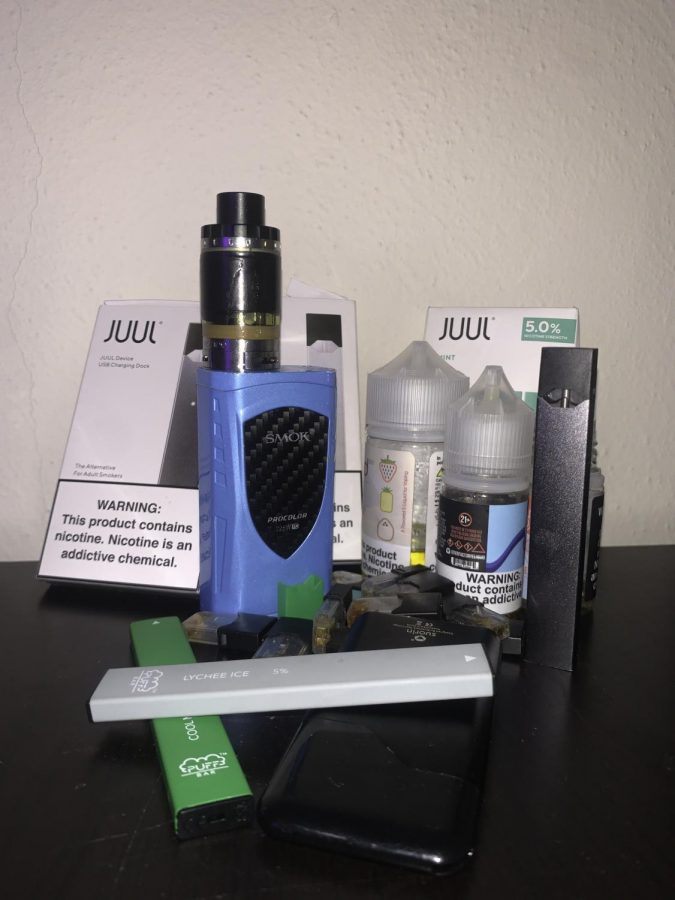Panel discusses dangers of vape products
December 2, 2019
After the ban on flavored vape products was appealed less than a month after it was announced, Governor Kate Brown and other Oregonians are unsure on whether or not vapes and e-cigarettes are actually dangerous.
The ban was originally put into effect on Oct. 15 as an executive order by Gov. Brown following two vape-related deaths in Oregon out of the 18 reported across the country. Then, on Oct. 17 the ban was halted in regards to flavored nicotine products after several companies sued the state.
In part, the danger lies in the fact that nicotine is a highly addictive drug and e-cigarette companies have engineered and advertised their products to increase appeal to young people, according to Marion Ceraso, an associate professor in the College of Public Health and Human Sciences at OSU.
Ceraso and three other speakers headed “The Truth About Vaping,” a panel hosted by ASOSU, the College of Public Health and Human Sciences, the Benton County Health Department and Student Health Services on Nov. 19, geared towards providing information on the topic of vaping.
“After years of progress in reducing traditional tobacco use, seeing the explosive growth in e-cigarette use among young people is particularly concerning,” Ceraso said. “Knowing what we know about the role of the industry in driving this epidemic makes this even more heartbreaking.”
Ceraso spoke of the ways in which tobacco companies have played a role play a role within the epidemic of vaping, focusing on their chemical engineering of products designed to be highly addictive, early marketing to youth through sweet flavors and social media campaigns, and ongoing lobbying to defeat health-protecting laws.
To the left of Ceraso sat Sara Hartstein, the health policy specialist at Benton County Health Department, who talked about the hidden dangers in constant vape use by people under the age of 18. From 2017-2018, there has been a 48% increase in middle schoolers who started vaping and a 78% increase in high schoolers across the country, according to Hartstein.
Roman Cohen, another panelist and marketing student at OSU, had experienced this increase in his own life after arriving at OSU. He took to vaping to acclimate to the college environment, and urges listeners to understand the way the big tobacco companies disproportionately market their products to minority communities.
“Knowing the facts about how vaping is targeted to communities of color, Black communities, Native communities, low income and queer comunities, and how these intersect, and seeing how this is the reality, knowing the community I come from and how it’s been impacted… makes me question ‘why am I still doing this?’” said Cohen, a third year marketing and business administration major and member of ASOSU.
Understanding the statistics of university students who vape and the targeted marketing towards minority communities, ASOSU coordinator of wellness affairs and public health student, Ammara Molvi, put together the event with hopes to inform people of the research that has been done regarding nicotine addictions so students can make their own decisions about whether or not to vape.
“There’s a lot of information surrounding vaping right now and people aren’t really sure what to believe or think which is why putting on this event was important. For this event and whenever I think about creating events or initiatives, what’s in the back of mind is ‘how do we create health equity for communities that have been marginalized?’” Molvi said.
Student Health Services provides resources for students who are struggling with nicotine addictions, more information can be found on the SHS website.

















































































![Newspaper clipping from February 25, 1970 in the Daily Barometer showing an article written by Bob Allen, past Barometer Editor. This article was written to spotlight both the student body’s lack of participation with student government at the time in conjunction with their class representatives response. [It’s important to note ASOSU was not structured identically to today’s standards, likely having a president on behalf of each class work together as one entity as opposed to one president representing all classes.]](https://dailybaro.orangemedianetwork.com/wp-content/uploads/2025/03/Screenshot-2025-03-12-1.00.42-PM-e1741811160853.png)

























